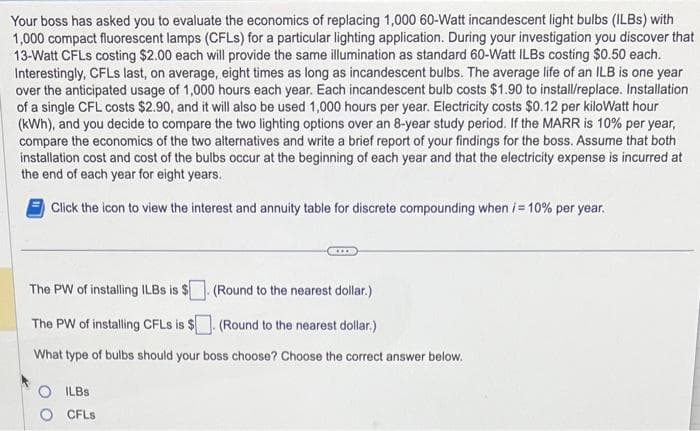Your boss has asked you to evaluate the economics of replacing 1,000 60-Watt incandescent light bulbs (ILBs) with 1,000 compact fluorescent lamps (CFLs) for a particular lighting application. During your investigation you discover that 13-Watt CFLs costing $2.00 each will provide the same illumination as standard 60-Watt ILBs costing $0.50 each. Interestingly, CFLs last, on average, eight times as long as incandescent bulbs. The average life of an ILB is one year over the anticipated usage of 1,000 hours each year. Each incandescent bulb costs $1.90 to install/replace. Installation of a single CFL costs $2.90, and it will also be used 1,000 hours per year. Electricity costs $0.12 per kilowatt hour (kWh), and you decide to compare the two lighting options over an 8-year study period. If the MARR is 10% per year, compare the economics of the two alternatives and write a brief report of your findings for the boss. Assume that both installation cost and cost of the bulbs occur at the beginning of each year and that the electricity expense is incurred at the end of each year for eight years. Click the icon to view the interest and annuity table for discrete compounding when i = 10% per year. *** The PW of installing ILBs is $ (Round to the nearest dollar.) The PW of installing CFLs is $. (Round to the nearest dollar.) What type of bulbs should your boss choose? Choose the correct answer below. ILBS CFLs
Your boss has asked you to evaluate the economics of replacing 1,000 60-Watt incandescent light bulbs (ILBs) with 1,000 compact fluorescent lamps (CFLs) for a particular lighting application. During your investigation you discover that 13-Watt CFLs costing $2.00 each will provide the same illumination as standard 60-Watt ILBs costing $0.50 each. Interestingly, CFLs last, on average, eight times as long as incandescent bulbs. The average life of an ILB is one year over the anticipated usage of 1,000 hours each year. Each incandescent bulb costs $1.90 to install/replace. Installation of a single CFL costs $2.90, and it will also be used 1,000 hours per year. Electricity costs $0.12 per kilowatt hour (kWh), and you decide to compare the two lighting options over an 8-year study period. If the MARR is 10% per year, compare the economics of the two alternatives and write a brief report of your findings for the boss. Assume that both installation cost and cost of the bulbs occur at the beginning of each year and that the electricity expense is incurred at the end of each year for eight years. Click the icon to view the interest and annuity table for discrete compounding when i = 10% per year. *** The PW of installing ILBs is $ (Round to the nearest dollar.) The PW of installing CFLs is $. (Round to the nearest dollar.) What type of bulbs should your boss choose? Choose the correct answer below. ILBS CFLs
Managerial Economics: Applications, Strategies and Tactics (MindTap Course List)
14th Edition
ISBN:9781305506381
Author:James R. McGuigan, R. Charles Moyer, Frederick H.deB. Harris
Publisher:James R. McGuigan, R. Charles Moyer, Frederick H.deB. Harris
Chapter5: Business And Economic Forecasting
Section: Chapter Questions
Problem 6E: The economic analysis division of Mapco Enterprises has estimated the demand function for its line...
Related questions
Question

Transcribed Image Text:Your boss has asked you to evaluate the economics of replacing 1,000 60-Watt incandescent light bulbs (ILBs) with
1,000 compact fluorescent lamps (CFLs) for a particular lighting application. During your investigation you discover that
13-Watt CFLs costing $2.00 each will provide the same illumination as standard 60-Watt ILBs costing $0.50 each.
Interestingly, CFLs last, on average, eight times as long as incandescent bulbs. The average life of an ILB is one year
over the anticipated usage of 1,000 hours each year. Each incandescent bulb costs $1.90 to install/replace. Installation
of a single CFL costs $2.90, and it will also be used 1,000 hours per year. Electricity costs $0.12 per kilowatt hour
(kWh), and you decide to compare the two lighting options over an 8-year study period. If the MARR is 10% per year,
compare the economics of the two alternatives and write a brief report of your findings for the boss. Assume that both
installation cost and cost of the bulbs occur at the beginning of each year and that the electricity expense is incurred at
the end of each year for eight years.
Click the icon to view the interest and annuity table for discrete compounding when i = 10% per year.
***
The PW of installing ILBs is $
(Round to the nearest dollar.)
The PW of installing CFLs is $. (Round to the nearest dollar.)
What type of bulbs should your boss choose? Choose the correct answer below.
ILBS
CFLs
Expert Solution
This question has been solved!
Explore an expertly crafted, step-by-step solution for a thorough understanding of key concepts.
Step by step
Solved in 3 steps with 3 images

Knowledge Booster
Learn more about
Need a deep-dive on the concept behind this application? Look no further. Learn more about this topic, economics and related others by exploring similar questions and additional content below.Recommended textbooks for you

Managerial Economics: Applications, Strategies an…
Economics
ISBN:
9781305506381
Author:
James R. McGuigan, R. Charles Moyer, Frederick H.deB. Harris
Publisher:
Cengage Learning

Managerial Economics: Applications, Strategies an…
Economics
ISBN:
9781305506381
Author:
James R. McGuigan, R. Charles Moyer, Frederick H.deB. Harris
Publisher:
Cengage Learning